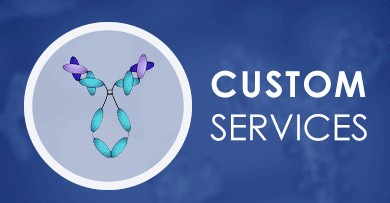+ Filter
 Loading...
Loading...

VTI1B
 Loading...
Loading...Anti-VTI1B Products
-
- Species Reactivity: Human, Mouse, Rat
- Type: Mouse IgG1
- Application: WB, FC, IF, ELISA
- AbPlus™ Anti-VTI1B Magnetic Beads (VS-0724-YC1088) (VS-0724-YC1088)
-
- Target: VTI1B
- Target Species: Human
- Application: IP, Protein Purification
- Recombinant Anti-Human VTI1B Antibody Fab Fragment (MOB-2862z-F(E))
-
- Derivation: Mouse
- Species Reactivity: Human
- Type: Fab
- Application: IP, Neut, FuncS
- Recombinant Anti-Human VTI1B Antibody scFv Fragment (MOB-2862z-S(P))
-
- Derivation: Mouse
- Species Reactivity: Human
- Type: scFv
- Application: WB, IP, FuncS
-
- Derivation: Phage display library
- Species Reactivity: Human, Mouse, Rat
- Type: Rabbit IgG
- Application: IHC-P, WB, ICC, IF, FC
View More Products
Can't find the products you're looking for? Try to filter in the left sidebar.Filter By Tag
More Infomation
Our customer service representatives are available 24 hours a day, from Monday to Sunday. Contact Us
For Research Use Only. Not For Clinical Use.
Background
VTI1B (Vesicle Transport Through Interaction With T-SNAREs 1B) is a Protein Coding gene. Diseases associated with VTI1B include Hypomyelinating Leukodystrophy. Among its related pathways are wtCFTR and deltaF508 traffic/Late endosome and Lysosome (norm and CF) and Response to elevated platelet cytosolic Ca2+. Gene Ontology (GO) annotations related to this gene include SNARE binding and chloride channel inhibitor activity. An important paralog of this gene is VTI1A.
Protein class
Transporters
Predicted location
Intracellular, Membrane (different isoforms)
Single cell type specificity
Cell type enhanced (Late spermatids)
Immune cell specificity
Low immune cell specificity
Cell line specificity
Low cell line specificity
Interaction
Forms a SNARE complex with STX7, STX8 and VAMP8 which functions in the homotypic fusion of late endosomes. Component of the SNARE complex composed of STX7, STX8, VAMP7 and VIT1B that is required for heterotypic fusion of late endosomes with lysosomes (By similarity). May interact with STX17 (PubMed:23217709). Interacts with CLINT1 (PubMed:18033301).
More Types Infomation



